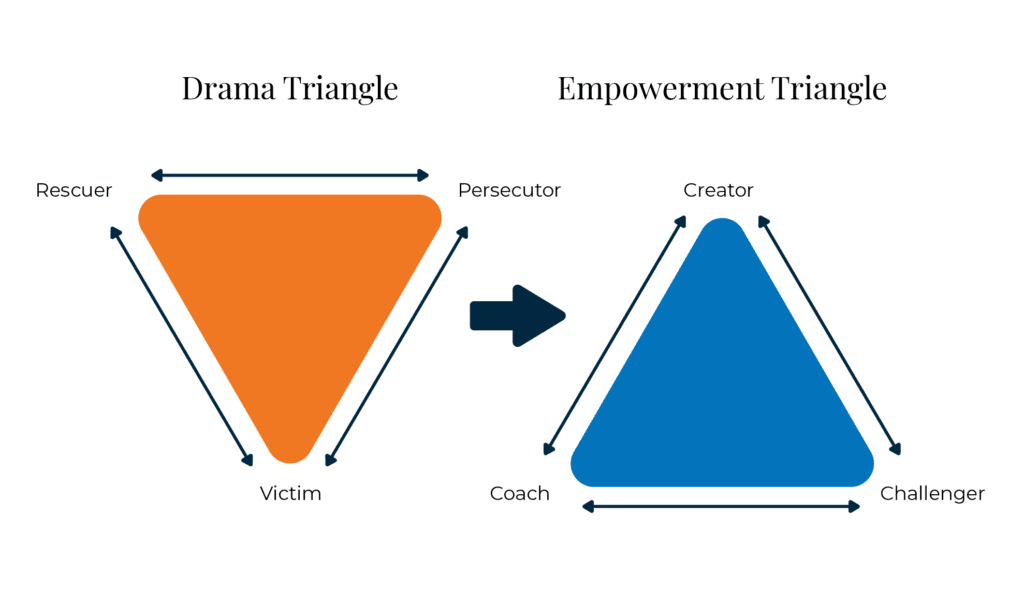Victims… we meet them in our work and at home; people who are invested in being the downtrodden one in every situation. Whether the situation is bad or good, it’s never their fault and good luck is never here to stay! A happy event is only minutes away from the next tragedy and their sense of powerlessness exudes through every conversation.
When they ask to join your morning walking group your heart sinks because you know the whole conversation will be about them and their misery. You know the best thing to do is to walk away from the relationship, but how? The Victim makes you feel like you’ve got to save them, or cheer them up but nothing you do is ever going to be enough.
Karpman is famous for his work with conflicted or drama-intense relationship transactions. His Drama Triangle describes the connection between personal responsibility and power in conflicts, and the destructive and shifting roles people play.
The Three Roles of the Drama Triangle
For Karpman, three roles become fixed in a typical drama triangle…
Firstly, the Victim. “Poor me!” The Victim gets stuck in their response of being victimised, downtrodden, abused, helpless, hopeless, ashamed. People in this role often perceive themselves as being unfairly treated or oppressed by external circumstances or other people. Victims tend to avoid taking responsibility for their actions. Unable to solve their own problems, he or she seeks out and become transfixed by a Persecutor.
The Persecutor, also known as the Villain, is seen to be controlling, blaming, critical, unkind, bossy and cynical. People in this role often adopt a judgmental and authoritarian stance, seeking to assert dominance and superiority. They may employ aggressive or manipulative tactics to maintain power and authority in relationships or situations. Paula says with surprise… “I said what I said, but I didn’t mean it that way! I was really surprised when I heard that I’d hurt her feelings and that she found me unkind, I was only trying to help.”
The third role is that of the Rescuer which revolves around the desire to save or fix others’ problems. People in this role often feel a sense of responsibility or duty to intervene in situations where they perceive someone as being in distress or need of assistance. The Rescuer feels guilty when they fail to rescue or to at least try. But they don’t see how their rescuing keeps the Victim dependent, never allowing him or her to fail. By rescuing, the rescuer focuses attention onto the Victim and so, for a while at least, his or her own anxieties become invisible and un-noticed. It may be difficult to acknowledge, but the motivation for the Rescuer is to avoid his or her own problems, whilst looking like a heroic martyr!
Karpman suggested that people instinctively adopt one of these roles in conflict situations and may switch roles based on convenience. The triangle begins to form with one point, either the Victim or the Persecutor, and others are drawn into the remaining roles. Ultimately, however, these roles do not effectively resolve conflicts or address underlying issues; instead, they perpetuate the problems at hand.

The Drama Triangle in a Workplace Scenario
Let’s explore a scenario in the workplace that you may have encountered:
Jane, the perpetual underdog. With her desk buried under a mountain of sticky notes and her coffee mug always half-empty, she is convinced that the universe has it out for her. Every setback, from a typo in an email to a printer malfunction, is further proof that life just isn’t fair. Mark, the fearless leader with a touch of the drill sergeant. Armed with spreadsheets and a killer PowerPoint game, Mark is determined to whip his team into shape and deliver results. Unfortunately, his enthusiasm for perfection sometimes crosses the line into “micromanagement meltdown,” leaving his team feeling more like cowering recruits than creative team members. Emma, the team’s guardian angel in designer heels. With a heart of gold and a long to-do list, Emma swoops in to save the day whenever her teammates hit a rough patch. From proofreading emails to acquainting herself with the printer’s manual, Emma’s motto is simple: “No problem too big, no task too small.” As the project deadline draws near, the drama reaches fever pitch. Sarah’s cries of “why me?” echo through the office, Mark’s colour-coded spreadsheets threaten to take over the world, and Emma’s superhero cape flutters in the air as she juggles a dozen tasks at once.
Getting lost in this triangle can end up as a full-time occupation. We can call it survival or game-playing, but it’s definitely not leadership. This type of subterranean emotional skulduggery goes on all of the time and leaders have to be able to deal with it, but in order to cope effectively, we have to transform it. Like other emotional dysfunctions, this movement to playing the victim is normal; in our darkest moments we all do it. The challenge for leaders and for people dealing with others in their own drama triangles happens when the behaviour becomes rigid, when people become locked into one of the roles. It’s hard when one person habitually makes sure he or she sits in the victim chair.
It’s one thing to know about the Drama Triangle and it’s another thing to start developing a plan to deal with it. The question here is “how can you deal with it as a leader?”
Like everything in leadership development, breaking through a rigid Drama Triangle is easy to describe and difficult to do. You will probably come face-to-face with victim-rescuer-persecutor behaviour in the context of a team that you might be the manager of, or that you might belong to. when you see it, repeatedly over different contexts and times, you’ll notice how the victim makes you feel. You are unlikely to feel nothing, but you might feel angered or sad, sorry for the victim. Quite possibly you will look at the “persecutor” and you will wonder why they are being so clear or so mean. Take another look and this time ask yourself, how is the victim making this happen? Sometimes the answer will be clearly, “he is not”. Sometimes people are victims of bullying or of situations that they have not caused, and often in this situation you might need to act to isolate the persecutor and to protect or re-engage the victim. This is different however, here I’m talking about a situation where the victim is in fact the one creating the cycle. As a leader in the context of a drama triangle, your job is to help people take on new roles.
The Empowerment Triangle
Everyone has the potential to shift from a mindset of victimhood and dependency to one of ownership and agency. As a leader, navigating through these complex dynamics requires a delicate balance of empathy, assertiveness, and a commitment to fostering growth and empowerment within the team.
The new roles, the Creator, the Coach and the Challenger, are the grown-up versions of the Drama roles and they make up The Empowerment Triangle (TED). Emerald and his team at The Center for The Empowerment Dynamic characterise this framework as: “a profound, yet clear and simple method to free yourself from your reactive habits.” Karpman himself has expressed support for the concept, calling TED “a highly original and effective escape from the Drama Triangle.”


Instead of being a Victim, the Creator accepts the fact that he/she cannot do everything alone and that they may be vulnerable. Instead of viewing themselves as a prisoner to circumstances and problems, they learn they “can choose their response to life’s challenges.” They embrace “what inspires them” and become focused on solutions and outcomes, not the weight of challenges holding them back. They ask and accept help, thus making themselves powerful in their own right and working towards an actual solution. Where the Victim says “I can’t”, the Creator says “I can”.
In the Empowerment Triangle, the Coach assumes a role similar to the traditional Rescuer or Hero. However, their approach differs significantly. A significant contrast lies in the act of listening rather than dictating. Instead of perpetuating victimhood, the Coach offers genuine support to Creators. Through the practice of inquiry, curiosity, and attentive listening, they empower others to find their own best solutions and paths forward.
Instead of being a Persecutor, the Challenger is assertive about his or her own needs, without blaming the creator. In both the classic Karpman roles and the newly proposed ones, these individuals often perceive themselves as truth-bearers who accurately assess situations. However, unlike the tendency to assign blame and dictate actions seen in the original roles, the Challenger takes a different approach. When they speak the truth, it is safe, and this often sparks learning and growth, which are very important for others to reach their potential. This individual consciously uplifts others, fostering an environment where everyone can learn and grow, even in the face of adversity.
Reimagined Workplace Scenario
Let’s reimagine the earlier scenario:
Jane, the innovative dynamo with a knack for thinking outside the box. When faced with setbacks, she doesn’t dwell on the problem but instead sees it as an opportunity for creative solutions. Whether it’s a last-minute design change or a technical glitch, she approaches each obstacle with a can-do attitude and a determination to find a way forward. Enter Mark, the fearless advocate for progress and growth. Instead of passively accepting the status quo, Mark challenges his teammates to push their boundaries and think bigger. When tensions rise or conflicts emerge, he doesn’t shy away from difficult conversations but instead encourages colleagues to confront their differences and find common ground. And last but not least, we have Emma, the supportive mentor and guide. With a keen ear for listening and a wealth of wisdom to share, she is always there to offer a helping hand or a word of encouragement. Instead of swooping in to rescue teammates, she empowers them to find their own solutions and discover their inner strengths. As the project progresses, the team faces its fair share of setbacks and challenges. But instead of succumbing to the drama and dysfunction, they lean on the principles of the Empowerment Triangle to navigate through rough waters. Together, they rewrite the narrative of the traditional office drama, transforming setbacks into opportunities, conflicts into collaborations, and challenges into triumphs.
Which team would you rather belong to?
While both the Drama and Empowerment Triangles may appear straightforward and uncomplicated, their impact is profound. They offer us a powerful tool for self-awareness, allowing us to recognise our instinctive reactions to challenges and subsequently modify our behaviour. All of this has to do with accepting responsibility for one’s own position, without asserting power over other people. And the beauty about this is, that as soon as someone accepts the empowerment version of their preferred role, the whole system changes, and the situation is lifted from Drama into Empowerment.
By promoting these alternative roles within the team, leaders can facilitate a culture of empowerment, accountability, and mutual respect. This transformation not only fosters healthier relationships but also enhances productivity, creativity, and overall well-being within the team.
Authors
James Ashton & Chevaughn van der Westhuizen

